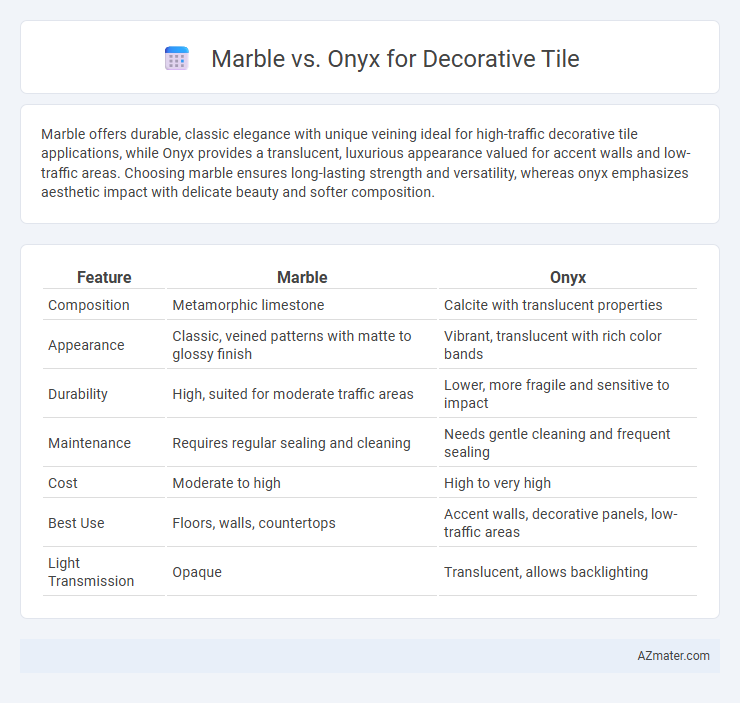Marble offers durable, classic elegance with unique veining ideal for high-traffic decorative tile applications, while Onyx provides a translucent, luxurious appearance valued for accent walls and low-traffic areas. Choosing marble ensures long-lasting strength and versatility, whereas onyx emphasizes aesthetic impact with delicate beauty and softer composition.
Table of Comparison
| Feature | Marble | Onyx |
|---|---|---|
| Composition | Metamorphic limestone | Calcite with translucent properties |
| Appearance | Classic, veined patterns with matte to glossy finish | Vibrant, translucent with rich color bands |
| Durability | High, suited for moderate traffic areas | Lower, more fragile and sensitive to impact |
| Maintenance | Requires regular sealing and cleaning | Needs gentle cleaning and frequent sealing |
| Cost | Moderate to high | High to very high |
| Best Use | Floors, walls, countertops | Accent walls, decorative panels, low-traffic areas |
| Light Transmission | Opaque | Translucent, allows backlighting |
Understanding Marble and Onyx: Key Differences
Marble and onyx differ significantly in composition and appearance, with marble primarily composed of calcite and known for its durability and subtle veining, while onyx, made of aragonite, features translucent properties and dramatic banding ideal for backlit decorative tiles. Marble's surface is more porous and less prone to scratching, making it suitable for high-traffic areas, whereas onyx requires careful maintenance due to its softness and susceptibility to etching and scratching. Choosing between marble and onyx depends on the desired aesthetic impact and maintenance capability, balancing marble's classic elegance with onyx's luxurious translucency.
Aesthetic Appeal: Visual Qualities Compared
Marble exhibits a classic, timeless aesthetic with its smooth, crystalline surface and subtle veining patterns that create a sense of elegance in decorative tiles. Onyx offers a unique translucency and vibrant color variations, allowing light to pass through and enhancing interior spaces with a luxurious, glowing effect. The distinct visual qualities of marble provide a more traditional luxury, while onyx delivers a striking, contemporary appeal for decorative tile applications.
Color and Pattern Variations
Marble offers a wide range of color options, including whites, greys, blacks, and greens, with subtle veining patterns that add elegance and timeless appeal to decorative tiles. Onyx features more vibrant and translucent colors like amber, honey, and white, with dramatic, swirling patterns that create a striking visual impact and unique depth. Both materials provide distinct aesthetic choices, with marble favoring classic sophistication and onyx delivering bold, artistic statements for interior design.
Durability and Longevity
Marble offers excellent durability and can withstand heavy foot traffic, making it a popular choice for decorative tiles in high-use areas. Onyx, while visually striking with its translucent qualities, is softer and more prone to scratches and etching, requiring careful maintenance to preserve its longevity. Choosing marble over onyx enhances durability and long-term performance in decorative tile applications.
Maintenance Requirements
Marble requires regular sealing to prevent stains and etching due to its porous nature, making consistent maintenance essential for preserving its polished appearance. Onyx, being softer and more delicate, demands even more cautious care, including gentle cleaning agents and avoidance of abrasive materials to maintain its translucency and prevent surface damage. Both stones benefit from prompt spill clean-up and professional resealing, but onyx's higher susceptibility to scratches and etching results in more intensive upkeep compared to marble.
Installation Challenges
Marble tiles require careful handling due to their porous nature, increasing the risk of staining and necessitating sealing before installation, while their weight demands strong substrate support to prevent cracking. Onyx tiles pose installation challenges with their translucency, often needing backlighting considerations and specialized adhesives to avoid discoloration or damage. Both materials require skilled installers to manage cutting precision and grout selection, ensuring longevity and maintaining aesthetic appeal.
Cost Comparison: Marble vs Onyx Tiles
Marble tiles generally cost between $10 to $40 per square foot, making them a more affordable option compared to onyx tiles, which range from $20 to $50 per square foot. The higher price of onyx is attributed to its rarity, translucency, and the complexity involved in extraction and processing. Homeowners and designers often choose marble for budget-conscious projects, while onyx is selected for luxury spaces where its unique aesthetics justify the premium cost.
Best Applications for Each Material
Marble is best suited for high-traffic areas like floors, countertops, and bathroom walls due to its durability and resistance to scratching. Onyx, with its translucent quality and striking veining, excels as accent walls, backsplashes, and decorative panels where lighting enhances its natural beauty. Both materials require proper sealing, but onyx is more delicate and ideal for low-traffic, visually impactful applications.
Environmental Impact and Sourcing
Marble and onyx, popular choices for decorative tiles, differ significantly in environmental impact and sourcing. Marble quarrying often involves extensive mining operations with notable carbon emissions and ecosystem disruption, while onyx is rarer and typically sourced from fewer locations, leading to higher transportation energy costs and market scarcity. Sustainable sourcing practices and certifications, such as the Natural Stone Sustainability Standard (ANSI/NSC 373), are critical for mitigating environmental harm in both materials.
Choosing the Right Stone for Your Space
Marble offers timeless elegance and durability with a wide range of colors and veining patterns, making it ideal for high-traffic areas like kitchens and bathrooms. Onyx provides a luxurious, translucent appearance with unique, colorful patterns that create a striking focal point, best suited for low-traffic or accent spaces due to its softer, more delicate nature. Consider your space's usage, lighting, and maintenance requirements when selecting between marble's robustness and onyx's dramatic aesthetic for decorative tile installations.

Infographic: Marble vs Onyx for Decorative Tile
 azmater.com
azmater.com